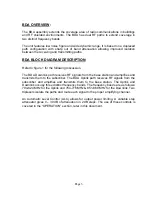
ELECTRICAL SPECIFICATIONS:
Frequency Range
Downlink
:
764-776
and
851-869
MHz
Uplink
:
794-824
MHz
Pass band Gain @ min attenuation
: 80 dB minimum
Variable Step Attenuator Range
: 0-30 dB
(2-dB steps)
Pass
band
Ripple
:
±1.5
dB
(typ)
Noise Figure @+25
°
C at max gain
: 5.5 dB max
3rd Order Intercept point
Uplink
:
+46
dBm
(typ)
Downlink
: +49 dBm (typ)
*Output Power @ 1dB Compression
Uplink
:
+33
dBm
(typ)
Downlink
:
+39
dBm
(typ)
*ALC Factory Set Point
Uplink
:
+25
dBm
Downlink
:
+3
2
dBm
Isolation between Up/Down Link
: 100 dB min
Input/
Output
Impedance
:
50
Ohms
VSWR (Input/Output)
: 1.5: 1 max
Pass band Gain @ min attenuation
: 80 dB minimum
Power
Supply
:
110VAC/1.42Amp
: 240VAC/0.71 Amp
: 50 to 60 Hz
*The Manufacturer's rated output power of this equipment is for single carrier operation. For situations
when multiple carrier signals are present, the rating would have to be reduced by 3.5 dB, especially
where the output signal is re-radiated and can cause interference to adjacent band users. This power
reduction is to be by means of input power or gain reduction and not by an attenuator at the output of
the device.
Page 5


























